A violin by Alessandro Gagliano, Naples, c. 1700
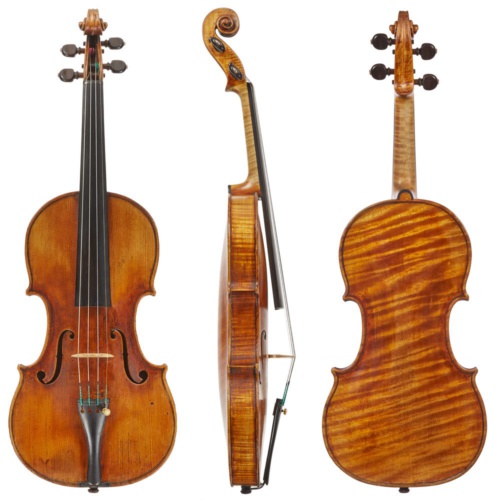
With flames as wide as an inch, set at a dramatic angle and of just enough irregularity to be interesting to the eye there are few violins of any age or origin made of a more jaw-dropping piece of wood.
There is much that is as of yet unknown about the origins of violin making in Naples, but the accepted history is that Alessandro was the first violin maker in that city and he worked between circa 1700 and 1730. One of the great mysteries of Neapolitan violin making is how did Alessandro learn his trade? On some of his labels he refers to himself as ‘Alumnus Stradivari’ but no evidence to support this has so far been discovered. Before 1700 makers of lutes and other stringed instruments are recorded as active in Naples, most of them of Füssen origins. Did he learn violin making from lute makers already active in the city? Or did he learn from some other unidentified violin maker in Naples who preceded him? Or perhaps, like many aspiring makers in far-flung outposts, he studied the instruments that were available to him and reverse-engineered the process.
But the problem with Alessandro is that somehow his instruments are simply too advanced, too consistent and too similar to the prevailing violin making of northern Italy to be the work of an autodidact working alone. If there was no maker in Naples with whom he could have trained and if a Cremonese apprenticeship is undocumented and unlikely, could it be that Cremona came to him? One of the most significant unexplained events of the Stradivari household is the departure of Omobono to Naples shortly before 1700 when he was about 20 years old. It’s not known if he was involved in violin making during the period he was in Naples and most evidence suggests he was not, but he was undoubtedly a fully fledged maker when he left Cremona and carried with him the secrets and the know-how of the world-famous Stradivari workshop. Could he have overlapped in some small way with a young and aspiring Alessandro Gagliano?
There is no evidence to support this and, to be clear, this is complete speculation. But somehow it’s a compelling theory: the son of Stradivari arrives in Naples and all at once a new tradition of violin making is borne out of thin air. There are strong similarities that need to be explained: why does Alessandro appear to have used an internal mould when the Füssen-trained lute makers would almost certainly not have done so? Why is Alessandro’s spectacular flamed maple so similar to Stradivari’s best wood from this period? Why do so many early Neapolitan tables find significant dendrochronological correlations with Cremonese wood? Why is Alessandro’s varnish so similar to the great Cremonese varnishes of c. 1690–1720? These are the elements that most home-grown reverse-engineered traditions fail at so miserably and yet Alessandro got them right.
I don’t want to propose this as anything more than speculation – it’s more likely that there was no direct connection between these two makers and the chronology is simply a coincidence. Hopefully in time research will shed more light on the inception of this great Neapolitan dynasty.
From our June 2016 London auction:
A violin by Alessandro Gagliano, Naples, c. 1700
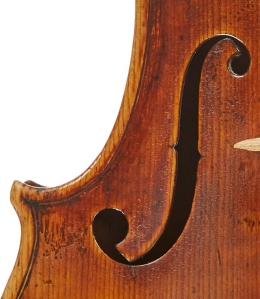
The most easily recognizable feature of an Alessandro violin is its soundholes: Amatise in pattern and concept and yet invariably set low in the table (shown with original notch position).
The first thing one notices about this c. 1700 violin is the spectacular piece of figured maple used for the one-piece back. Its flames are as wide as an inch, set at a dramatic angle and of just enough irregularity to be interesting to the eye – there are few violins of any age or origin made of a more jaw-dropping piece of wood. The ribs by comparison are also quarter sawn but with much narrower and almost completely horizontal flames. While most makers try to match the sides to the back in terms of both the size and orientation of figure, Alessandro seems to have frequently employed this mismatch of a highly flamed back with narrowly figured ribs. The 1710 ‘Rotundo’ is a fine example of this, as is this 1706 violin that Tarisio sold some years ago.
Over the deeply figured back the varnish is glorious and rivals the best of any of the established northern Italian traditions.
Another common feature of Alessandro’s violins, which is often later corrected, is that the ribs are often low, frequently measuring below 28mm in height. The ribs on this instrument have not been raised but show a reversed taper measuring a scant 30mm at the top block and 28.5mm at the lower block. Just as Alessandro’s ribs are often slightly low, the C-bout width of the model he used was narrow and occasionally corrected by later restorers to be slightly wider, as is the case with this violin. The current bout measurements of this instrument are a generous 16.4cm in the upper bouts, 11.1cm in the C-bouts and 20.2 in the lower. The model works better visually and acoustically with an extra millimeter or two in the center, and the extra width stops the central arch from being bulbous or overly peaked. To see the outline as it would have looked originally, see the illustration below.
The most easily recognizable feature of an Alessandro violin is its soundholes: Amatise in pattern and concept and yet invariably set low in the table, they often yield a slightly long body-stop of 196–200mm. This is usually corrected by restorers who fill and re-set the placement of the inner notch to a normal 195mm length. The C-bouts themselves are also rather open and long, reinforcing the impression of the model being low-waisted and high-shouldered.
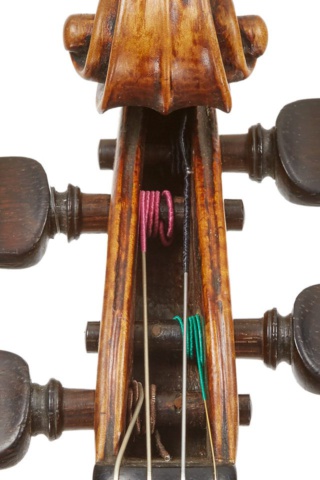
A distinctive feature of many of Alessandro’s scrolls is the narrow fluting on the top of the pegbox walls which starts at the fingerboard and terminates just under the volute
The purfling appears to be in poplar and is set in a narrow and variable channel. The dyed strips have held their color except where exposed to perspiration. The corners are crudely mitred and the strips are often broken at the tightest curves leading into the corners. The fluting is minimal and the edge rounds in a tight bead with a small overstand. Often Alessandro corners are somewhat hooked, particularly in the upper corners, but that’s not the case with this example.
The head is graceful but slightly petite measuring just 36.2mm between the eyes. The turns of the volute are noticeably asymmetrical with a narrower spiral on the treble side, but the asymmetry is barely noticed in the front and rear views. The chamfer throughout is generously rounded and gives the head a softened and smoothed-over appearance. A distinctive feature of many of Alessandro’s scrolls is the narrow fluting on the top of the pegbox walls, which starts at the fingerboard and terminates just under the volute. This is occasionally seen in lute and mandolin heads – either fluted or inlaid with a strip of ivory or shell – and perhaps this served as his inspiration.
The varnish is of a beautiful and rich red-brown colour that craquels slightly at its thickest applications. Over the deeply figured back the varnish is glorious and rivals the best of any of the established northern Italian traditions.
-Jason Price
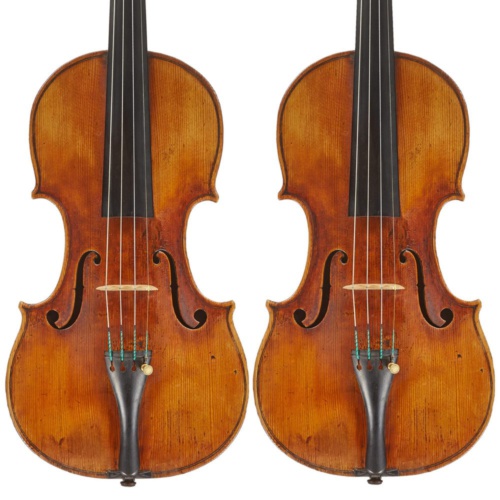
The current centre bout widths (right) and a rendering of the original widths (left).
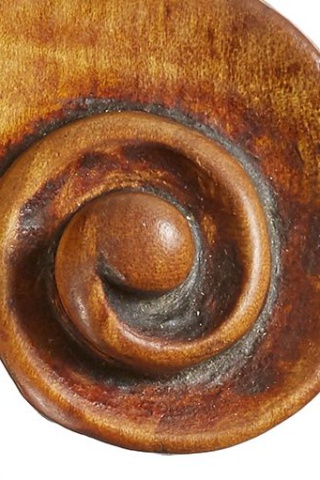
The chamfer throughout is generously rounded and gives the head a softened and smoothed-over appearance.
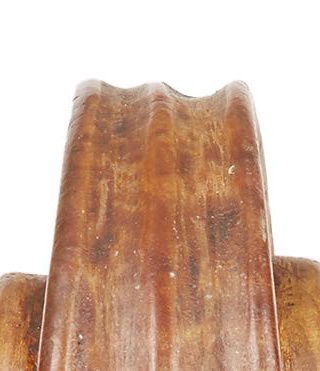
The turns of the volute are noticeably asymmetrical with a narrower spiral on the treble side. Also notice the wildly different fluting depths at each side of the centre-line at the crown of the head.